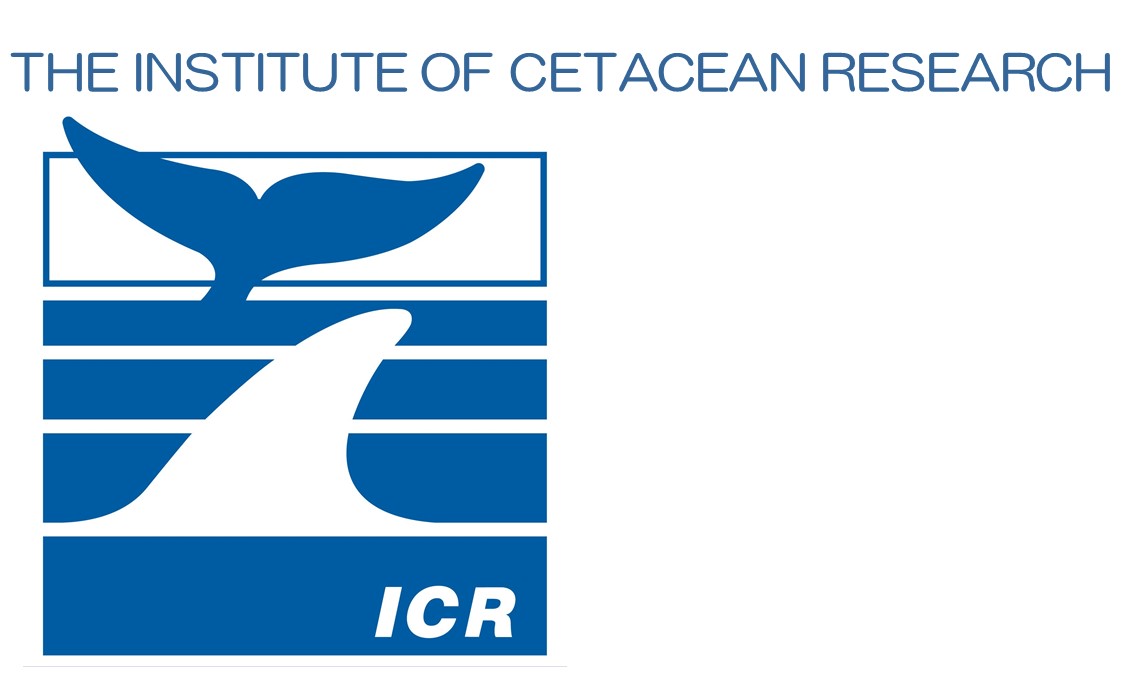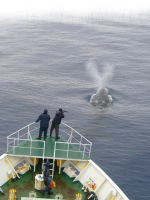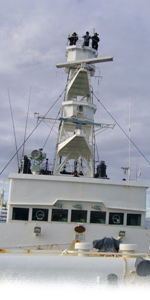Greenpeace harassment - Arctic Sunrise rams the Nisshin Maru
Japan's Antarctic Research Programme, legally authorized by Article VIII of the International Convention for the Regulation of Whaling, has been continually subject to harassment and obstruction by Greenpeace.
On December 21, 1999, while harassing the Japanese whale research operations in the Antarctic, the Greenpeace vessel Arctic Sunrise rammed the stern section of the Nisshin Maru, in callous disregard of the life or safety of the scientists and seamen aboard. Greenpeace, recently refused classification as a charity by the Canadian government because it does not operate in the public interest, again demonstrated that it will stop at nothing to create the publicity it needs to support incessant fund-raising campaigns that bring in over $100 million a year.
Although Greenpeace claims to be a peaceful, non-violent organization, its actions belie its words. This is the second time a Greenpeace vessel has rammed a Japanese research vessel in the Antarctic. This time, it tried to make it appear that the ramming was done by the Japanese vessel and published the following cover-up "communique" on its web-site.
"14:20 - The Nisshin-maru has rammed the M/V Arctic Sunrise. Sunrise captain Arne Sorensen confirmed that the Nisshin-maru rammed the Greenpeace ship while the Nisshin-maru was making an illegal overtaking maneouvre (SIC). It hit the Sunrise on the portside near the bow."
However, as can be seen in the photos, the Japanese vessel was damaged near its stern on the starboard side. If it had rammed the Greenpeace vessel while overtaking it from behind, damage would be at or near the bow, while the M/V Arctic Sunrise would most likely have suffered damage at the stern or amidships. The damage pattern on the Nisshin Maru shows conclusively that it was caused by a vessel striking it from behind.
Greenpeace freely uses lies, distortions and half-truths in support of its fund raising goals. And nowhere are these tools more evident than in their anti-whaling campaigns. They create fears of extinction where no threats exist. They untruthfully label Japan's Antarctic whale research program illegal when they know that the program is perfectly legal in terms of the international whaling convention, the UN Convention on the Law of the Sea and all other international legal compacts.
On December 20, 1999, Greenpeace commenced its latest effort to harass, obstruct and interfere with Japan's whale research program in the Antarctic. The Institute of Cetacean Research, in an effort to persuade Greenpeace to stop their vicious slander and extremely hazardous and life-threatening assaults on the Japanese research vessels, engaged in the following exchange of letters with Greenpeace Executive Director Thilo Bode . . . .
Collision Damage Photos
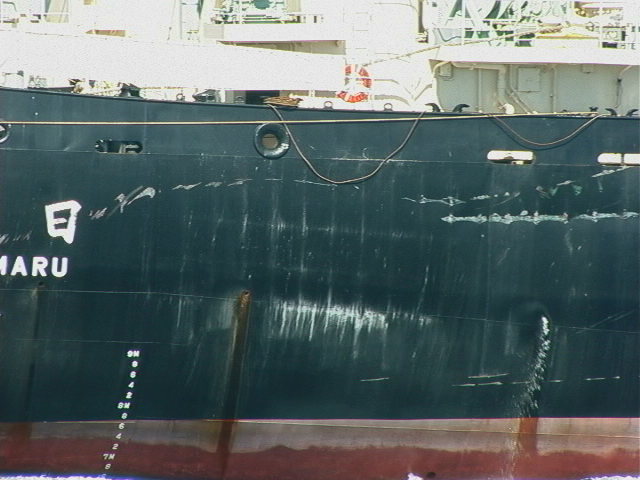 |
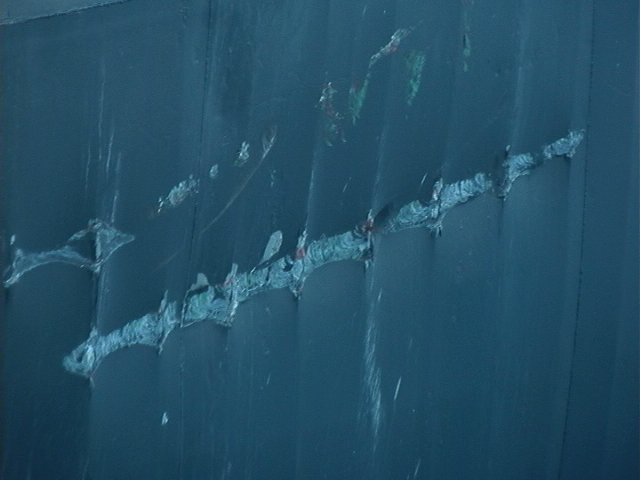 |
The starboard stern shell of the Nisshin Maru Plates and paint were pushed
after it was rammed by the Arctic Sunrise. forward by the ramming, showing it was hit by a vessel coming up from behind.
For the record
FACSIMILE MESSAGE
December 27, 1999
Mr. Thilo Bode
Executive Director
Greenpeace International
Keizersgracht 176
1016 DW Amsterdam
The Netherlands
Fax: 31 20 523 62 00
Mr. Bode:
As you are aware, the legal basis for Japan's whale research in the Antarctic is Article VIII of the 1946 International Convention for the Regulation of Whaling (ICRW) which unequivocally provides that Contracting Parties may grant permits authorizing the take of whales for purposes of scientific research. Further, claims by Greenpeace that Japan is breaking international law or that its research whaling is illegal because of its obligations under the United Nations Convention on the Law of the Sea (UNCLOS) are a misrepresentation of fact. The UNCLOS obliges States to "work through the appropriate international organizations" for the conservation, management and study of cetaceans. This obligation is clearly met since Japan's research program is conducted in accordance with the terms of the ICRW and supported by the IWC's Scientific Committee. The Government of Japan continues to work through the IWC in an effort to bring the work of the Commission in line with the objectives and purposes of the ICRW.
The issue of scientific research on whales is of vital importance to the IWC since the Convention prescribes that regulations adopted by the Commission shall be based on scientific findings. I am sure you are aware that Japan's research program in the Antarctic has been the subject of extensive review by the IWC's Scientific Committee. The Scientific Committee has noted that the program has provided considerable data which could be directly relevant for management and that the results of this program have the potential to improve the management of minke whales. The Scientific Committee has also noted that non-lethal means to obtain some of this information are unlikely to be successful in the Antarctic.
With regard to the Southern Ocean Sanctuary, it should be noted that contrary to the principle that the management of living resources should be based on scientific findings, the Southern Ocean Sanctuary prohibits the commercial taking of whales "irrespective of the conservation status of baleen and toothed whales in this Sanctuary". The Sanctuary was adopted in 1994 in the absence of advice from the Scientific Committee that such measure was necessary to carry out the objectives and purposes of the ICRW and to provide for the conservation, development and optimum utilization of whale resources. This action by the Commission ignored Article V 2. of the ICRW which requires that regulations "shall be such as are necessary to carry out the objectives and purposes of this Convention..." , "shall be based on scientific findings..." and "shall take into consideration the interests of the consumers of whale products and the whaling industry." The IWC has been provided with a comprehensive legal analysis related to the designation of the Southern Ocean Sanctuary which concludes that the IWC exceeded its authority under the Convention and that the establishment of the Southern Ocean Sanctuary violates the treaty. Notwithstanding this, the Southern Ocean Sanctuary applies to commercial whaling. It does not apply to the taking of whales for research purposes.
Finally, you should be aware that while conducting research, the Nisshin-maru clearly shows that it is doing so and, as was the case with the Greenpeace vessel, Arctic Sunrise, always warns other vessels not to come within 2 miles of her. The Greenpeace vessel ignored these warnings and unnecessarily approached the Nisshin-maru for its own purposes.
I strongly urge you to direct the Greenpeace vessel to cease its activities which are a danger to our crews and scientists and to refrain from interfering in our legal research efforts which are making a significant contribution to science related to the management of cetaceans in the Antarctic. The unjustifiable activities of Greenpeace against our legal research program will not deter us.
Seiji Ohsumi
Director General
The Institute of Cetacean Research
cc: Sanae Shida
Executive Director
Greenpeace Japan
Dr. Seiji Ohsumi 28 December 1999
Director General
Institute of Cetacean Research
Tokyo Suisan Building
4-18 Toyomi-cho
Chuo-ku Tokyo 104-0055
Japan
Dear Dr. Ohsumi:
We are in receipt of your letter of 27 December. As you acknowledge, the United Nations Convention on the Law of the Sea (UNCLOS) to which Japan is a Party obliges States to work with the appropriate international organizations for their conservation, management and study.
You claim that this obligation is "clearly met since Japan's research program is conducted in accordance with the terms of the ICRW and supported by the IWC's Scientific Committee." I am afraid that the facts do not support your interpretation. The IWC has repeatedly called for this program to be terminated, most recently at its 1999 meeting in Resolution IWC 1999 - 3, the operative part of which said: "REQUESTS that the Government of Japan refrain from issuing any permits in the 1999/2000 seasons for the take of minke whales in the Southern Ocean Whale Sanctuary and in the North Pacific Ocean." Far from supporting this program, when the Scientific Committee conducted a review of it in 1997 they found that the data produced by the program were 'not required for management'.
You are concerned that the Southern Ocean Sanctuary prohibits the commercial taking of whales 'irrespective of the conservation of status of baleen and toothed whales in this sanctuary'. It does so because a whale sanctuary, by its nature, prohibits all whaling within its limits. There is considerate precedent for this. The Indian Ocean Sanctuary, established in 1979 (which was respected by Japan) prohibited whaling 'irrespective of the classifications of baleen or toothed whale stocks in the Sanctuary'. When the IWC was established it inherited a sanctuary (called The Sanctuary) which covered 1/4 of the Southern Ocean where all whaling was prohibited. Its purpose was to protect healthy populations of whales and this was accepted by Japan.
Japan is thus flouting the requirements in Articles 65 and 120 not only that it co-operates with a view to the conservation of marine mammals but specifically that in the case of cetaceans in particular it works through the appropriate international organizations for the conservation, management and study. Your failure to observe and even accept the validity of the Southern Ocean Sanctuary as well as your continued hunting of whales shows that far from working through the IWC for conservation management and study, Japan is carrying out its whaling and its so-called scientific whaling program despite the IWC and its resolutions.
In fact, since the IWC has made this area a sanctuary, where commercial hunting is not allowed, your entire research program is without. foundation. Your claim that results from this program may have the potential to improve management of minke whales is thus irrelevant since what you mean by management is commercial hunting and the area has already been made a sanctuary from commercial hunting.
The illegal whaling activities have been compounded by poor seamanship. Already the Nisshin Maru has collided with the M/V Arctic Sunrise in breach of its obligations under the International Collision Regulations and Greenpeace holds the owners, charterers and all responsible parties liable for the consequences of the collision.
I note your statement that you are warning other vessels not to come within 2 miles of the Nisshin Maru. Our ships crew report that this message has been conveyed to them as the following throat broadcast over loudspeakers from the Nisshin Maru: "Stay 2 miles away for safety reasons or we will water you".
This represents an escalation in your willingness to breach maritime as well as international law and the basic tenets of seamanship. You have no right to declare an exclusion zone of 2 miles (or any other exclusion zone). All vessels enjoy the right of freedom of navigation on the high seas and any attempt to restrict this freedom would represent a breach of international and maritime law,
I note that these continuing violations are a result of your continued whaling activities. I call on you to immediately rescind this threat and cease and desist from your whaling activities forthwith,
Yours sincerely,
Thilo Bode
Executive Director
Greenpeace International
CC: Sanai Shida, Executive Director, Greenpeace Japan
January 6, 2000.
Mr. Thilo Bode
Executive Director
Greenpeace International
Keizersgracht 176
1016 DW Amsterdam
The Netherlands
Mr. Bode:
I acknowledge receipt of your letter of December 28, 1999.
The legal and scientific basis of Japan's whale research program in the Antarctic was clearly set out in my letter of December 27, 1999. I must therefore conclude that your continued misrepresentations of this research program along with inaccurate interpretations of the articles of the UNCLOS and other international law and your false descriptions of the collision between the Arctic Sunrise and the Nisshin Maru are part of Greenpeace's misleading fundraising propaganda.
In fact, Japan's whale research in the Antarctic is a right accorded to all Parties to the International Convention for the Regulation of Whaling by Article VIII thereof. Further, and contrary to your assertions, nothing in the UNCLOS, the IWC's Southern Ocean Sanctuary or the IWC's non-binding resolutions infringe on that right. The IWC's Southern Ocean Sanctuary is contrary to the Convention because it ignores Article V 2.which requires that regulations "(a) shall be such as are necessary to carry out the objectives and purposes of this Convention and to provide for the conservation, development, and optimum utilization of the whale resources; (b) shall be based on scientific findings;". Similarly, resolutions of the IWC urging its members to refrain from conducting research such as the resolution adopted at the 1999 meeting and referred to in your letter of December 28,1999, are contrary to the Convention since they request a sovereign state to give up its rights accorded by
Article VIII of the Convention without scientific basis. In this regard, it is important to note that Articles of a Convention agreed to by contracting States cannot be changed by simple majority votes to adopt non-binding resolutions. The resolution referred to above also ignores the substantial scientific contribution of Japan's whale research program as noted by IWC's Scientific Committee.
Again, contrary to your description, the collision between the Arctic Sunrise and the Nisshin Maru was the result of the reckless and unnecessary approach of the Arctic Sunrise for Greenpeace's own publicity purposes. Your statements that this collision was the fault of the Nisshin Maru and that the Nisshin Maru was in breach of maritime law contradict the facts. I would also point out that the freedom of navigation on the high seas which you are claiming does not include the right to trespass or the right to commit other violent and illegal acts which have been a part of the current Greenpeace campaign against our whale research program. As I noted in my letter of December 27, 1999, we will not be deterred by the activities of Greenpeace. Your donating public deserves to know the facts of these matters.
Seiji Ohsumi
Director General
cc: Sanae Shida, Executive Director, Greenpeace Japan
January 14, 2000.
Mr. Thilo Bode
Executive Director
Greenpeace International
Keizersgracht 176
1016 DW Amsterdam
The Netherlands
Mr. Bode:
Your letter of January 7, 2000 continues to misrepresent the facts concerning Japan's research program in the Antarctic and related matters. As I have emphasized previously, our whale research program has a sound legal and scientific basis. Contrary to the statements of Greenpeace, this program is perfectly legal under international law. All of the points in your letter have been addressed in my previous correspondence to you.
As you know, Greenpeace activists have escalated their illegal and confrontational activities by entering the slipway of the Nisshin Maru in spite of warnings from the ships crew to stay away. I take this opportunity to inform you that should there be a recurrence of such activity, the Captain of the Nisshin Maru will, under Japanese domestic law, take the activists into custody. Our policy has always been to place the highest priority on human life and the safety of human beings. However, the activities of Greenpeace involving the close contact between vessels at sea and close contact between themselves and the research operations are posing serious risks to the safety of both themselves and our crews. This, in spite of continuous warning from the crew of the Nisshin Maru is continuing.
I urge you to order Greenpeace activists to cease these illegal and dangerous activities. Any further intrusion into our vessels will be dealt with according to Articles 25-27 of the Mariner's Law of Japan and Article 130 of the Criminal Law of Japan. Further, I believe that this escalation of violence by Greenpeace is piracy as defined by Article 101 of UNCLOS.
Seiji Ohsumi
Director General
cc: Sanae Shida, Executive Director, Greenpeace Japan
